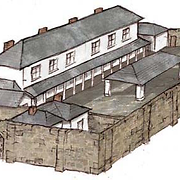
Yard Four at the Female Factory, Cascades, courtesy of Female Convicts Research Centre Inc..
Details
The Contagious Diseases Hospital was established at the Female Factory, Cascades in 1879. Initially the government ran it but in 1895, the committee of the Home of Mercy, a Church of England rescue home, took it over. The Hospital was for women and girls suffering from sexually transmitted diseases. It closed in 1900.
The Contagious Diseases Hospital was situated in almost all of Number One and Number Two Yards at the Female Factory, Cascades. In 1891, it moved to Number Four Yard. The Home of Mercy was also in Number Four Yard.
The Contagious Diseases Hospital operated under the Contagious Diseases Acts 1879, 1881, and 1882 which provided for the compulsory treatment of women with sexually transmitted diseases, especially syphilis. Most of the patients were aged between 16 and 45. They remained in the hospital for between two and 12 weeks. The government expected to cater for large numbers of patients and so initially they allocated almost all of Number One and Number Two Yards to the hospital. Despite these expectations, only about 100 women were treated each year. On average, 50 of those were in the Hospital voluntarily.
The Hospital had two wards. According to the Superintendent, Dr John Coverdale, the largest was for the 'worst characters', and the other for the 'less depraved'. He placed the 'more difficult' patients in solitary confinement. In 1880, the Administrator of Police criticised the Matron for not supervising the wards once the young women were locked up for the night. Coverdale replied that no one was willing to stay in the wards at night and if they did would be unable to defend themselves.
In So much hard work, Kay Daniels wrote that, between 1879 and 1890, parents or the police occasionally took children to the Hospital. From the 1890s onwards, children were increasingly placed there, although the reason why is not clear. In 1900, the Secretary of the Neglected Children's Department sent a 10 year old girl to the Hospital.
Arnot suggests that contagious diseases hospitals in general were 'actually more like prisons than hospitals'. This aptly describes the Contagious Diseases Hospital at Cascades which apparently had a grim reputation. In 1884, the Superintendent of Police, suggested that women dreaded a sentence in the Hospital more than prison.
Sources used to compile this entry: Arnot, Meg, 'The Oldest Profession in a New Britannia', in Burgmann, V. and Lee, J. (eds), Constructing a Culture: A People's Identity of Australia, McPhee Gribble, Melbourne, 1988, pp. 42-62. Also available at http://web.archive.org/web/20120111093926/http://www-old.infoxchange.net.au/wise/HEALTH/Pros1.htm; Brown, Joan C., 'Poverty is not a crime': the development of social services in Tasmania, 1803-1900, Tasmanian Historical Research Association, Hobart, 1972, 192 pp; 'Cascades Female Factory Ruins', in Australian Heritage Places Inventory, Australian Government, https://web.archive.org/web/20190308091043/https://dmzapp17p.ris.environment.gov.au/ahpi/action/search/heritage-search/record/RNE11027; Scripps, L. and Hudspeth, A, The Female Factory Historic Site: Historical Report, unpublished report for Department of Parks, Wildlife and Heritage, 1992; Tasmanian Heritage Council, Proposed Amendment to the Tasmanian Heritage Register entry for the Cascades Female Factory, South Hobart. Information Package., 2007, https://nla.gov.au/nla.obj-1838060114/view.
Prepared by: Caroline Evans
Created: 15 March 2011, Last modified: 29 November 2017